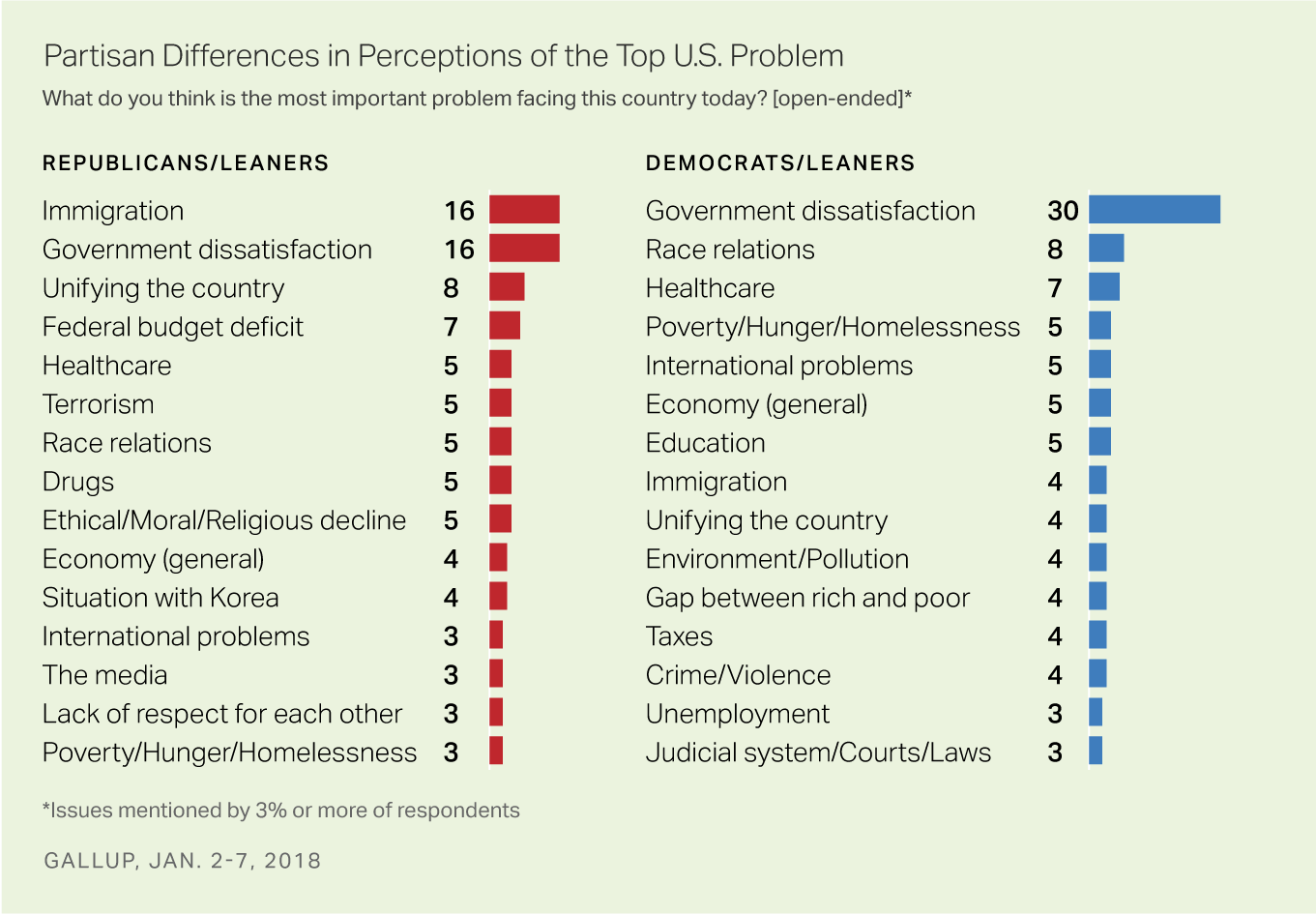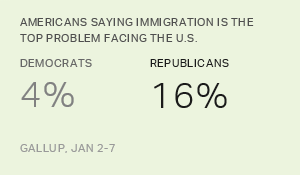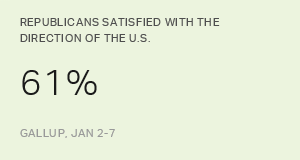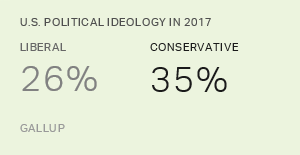Story Highlights
- Dissatisfaction with government is top problem overall
- Immigration ties with government as the top problem among Republicans
- 16% of Republicans vs. 4% of Democrats name immigration as top problem
WASHINGTON, D.C. -- Partisan differences are clearly visible in Americans' assessments of the most important problem facing the country. Dissatisfaction with government ranks at or near the top of the list of the country's most important problems for both Republicans (16%) and Democrats (30%), though the percentages differ substantially. But while immigration ties dissatisfaction with government as the top problem among Republicans, it appears much lower on the list among Democrats.

Mentions of immigration among Republicans and independents who lean toward the GOP are up to 16% from 9% last month, while just 4% of Democrats and Democratic leaners mention immigration as the most important problem. Immigration-related issues are at the center of congressional leaders' ongoing efforts to reach a budget deal and avoid a federal government shutdown.
Although dissatisfaction with government ranks at the top of the list among both Democrats and Republicans, almost twice as many Democrats (30%) as Republicans (16%) mention it. This largely reflects Democrats' mentions of President Donald Trump or the presidency in particular.
Third on the list of most important problems for Republicans is unifying the country (8%), followed closely by the federal budget deficit (7%). Among Democrats, race relations (8%) and healthcare (7%) rank behind government on their list.
There are also similarities between the two partisan groups. Healthcare continues to be a concern, with 7% of Democrats and 5% of Republicans citing it as a key issue. Additionally, 5% of Democrats and 3% of Republicans mention poverty, hunger and homelessness as a major problem facing the U.S.
Overall, Little Change in Americans' Views of the Country's Problems
Among Americans overall, there has been relatively little change this month in views of the most important U.S. problem. Government dissatisfaction continues to top the list, with mentions up three percentage points to 25% in January. Mentions of immigration also rose three points to 8%. This is likely attributable to media coverage of negotiations to extend the Deferred Action for Childhood Arrivals (DACA) program, which came into prominence during the survey.
| December 2017 | January 2018 | ||||||||||||||||||||||||||||||||||||||||||||||||||||||||||||||||||||||||||||||||||||||||||||||||||
|---|---|---|---|---|---|---|---|---|---|---|---|---|---|---|---|---|---|---|---|---|---|---|---|---|---|---|---|---|---|---|---|---|---|---|---|---|---|---|---|---|---|---|---|---|---|---|---|---|---|---|---|---|---|---|---|---|---|---|---|---|---|---|---|---|---|---|---|---|---|---|---|---|---|---|---|---|---|---|---|---|---|---|---|---|---|---|---|---|---|---|---|---|---|---|---|---|---|---|---|
| % | % | ||||||||||||||||||||||||||||||||||||||||||||||||||||||||||||||||||||||||||||||||||||||||||||||||||
| Dissatisfaction with government | 22 | 25 | |||||||||||||||||||||||||||||||||||||||||||||||||||||||||||||||||||||||||||||||||||||||||||||||||
| Immigration | 5 | 8 | |||||||||||||||||||||||||||||||||||||||||||||||||||||||||||||||||||||||||||||||||||||||||||||||||
| Race relations | 8 | 7 | |||||||||||||||||||||||||||||||||||||||||||||||||||||||||||||||||||||||||||||||||||||||||||||||||
| Healthcare | 5 | 6 | |||||||||||||||||||||||||||||||||||||||||||||||||||||||||||||||||||||||||||||||||||||||||||||||||
| Unifying the country | 8 | 5 | |||||||||||||||||||||||||||||||||||||||||||||||||||||||||||||||||||||||||||||||||||||||||||||||||
| Economy (general) | 3 | 4 | |||||||||||||||||||||||||||||||||||||||||||||||||||||||||||||||||||||||||||||||||||||||||||||||||
| Poverty/Hunger/Homelessness | 2 | 4 | |||||||||||||||||||||||||||||||||||||||||||||||||||||||||||||||||||||||||||||||||||||||||||||||||
| International problems | 1 | 4 | |||||||||||||||||||||||||||||||||||||||||||||||||||||||||||||||||||||||||||||||||||||||||||||||||
| Education | 2 | 3 | |||||||||||||||||||||||||||||||||||||||||||||||||||||||||||||||||||||||||||||||||||||||||||||||||
| Crime/Violence | 2 | 3 | |||||||||||||||||||||||||||||||||||||||||||||||||||||||||||||||||||||||||||||||||||||||||||||||||
| Federal budget deficit | 3 | 3 | |||||||||||||||||||||||||||||||||||||||||||||||||||||||||||||||||||||||||||||||||||||||||||||||||
| Lack of respect for each other | 5 | 3 | |||||||||||||||||||||||||||||||||||||||||||||||||||||||||||||||||||||||||||||||||||||||||||||||||
| Drugs | 1 | 3 | |||||||||||||||||||||||||||||||||||||||||||||||||||||||||||||||||||||||||||||||||||||||||||||||||
| Gap between rich and poor | 2 | 3 | |||||||||||||||||||||||||||||||||||||||||||||||||||||||||||||||||||||||||||||||||||||||||||||||||
| Judicial system/Courts/Laws | 3 | 3 | |||||||||||||||||||||||||||||||||||||||||||||||||||||||||||||||||||||||||||||||||||||||||||||||||
| Gallup | |||||||||||||||||||||||||||||||||||||||||||||||||||||||||||||||||||||||||||||||||||||||||||||||||||
A historically low 4% of Americans cite the economy in general terms as the nation's top problem, reflecting low unemployment, a strong stock market and other signs of a healthy economy. More broadly, relatively few Americans -- 20% -- mention any economic issue as the country's most important problem.
Bottom Line
Cracking down on immigration was a key platform in Trump's presidential campaign. An apparent victory in negotiations over DACA, the border wall and immigration in general may appeal to his Republican supporters, but it's less likely to lift his approval among Americans overall.
While Democrats and Republicans differ on whether immigration is a key problem for the country, large percentages of both groups remain dissatisfied with government. Dissatisfaction may only increase if Trump and members of Congress are unable to hammer out an agreement to avoid a government shutdown.
One continued bright spot for Americans is the economy, which few note as a top problem -- a pattern that was evident in 2017 and appears likely to continue.
Survey Methods
Results for this 优蜜传媒poll are based on telephone interviews conducted Jan. 2-7, 2018, with a random sample of 1,024 adults, aged 18 and older, living in all 50 U.S. states and the District of Columbia. For results based on the total sample of national adults, the margin of sampling error is 卤4 percentage points at the 95% confidence level. All reported margins of sampling error include computed design effects for weighting.
Each sample of national adults includes a minimum quota of 70% cellphone respondents and 30% landline respondents, with additional minimum quotas by time zone within region. Landline and cellular telephone numbers are selected using random-digit-dial methods.
View survey methodology, complete question responses and trends.
Learn more about how the works.





